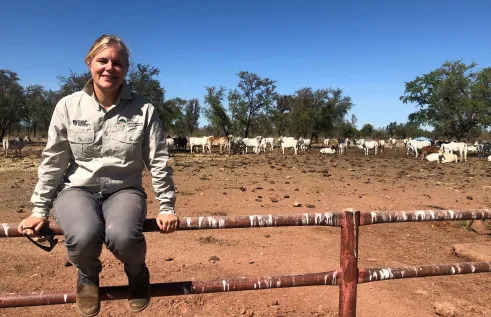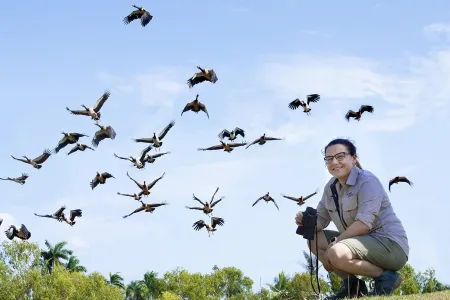News article
Weather radars reign for info on flying animals
Scientists are using weather radars, originally developed to measure rainfall, to study the flight patterns of birds, bats and insects. A researcher claims, however, that we should use radars to measure flying animals more often.
Charles Darwin University PhD candidate Rebecca Rogers said weather radars could provide information about the number of animals in the air, the height of their flight path, and the speed and direction of their flight.
“We can use this information with other techniques such as GPS tracking devices and aerial survey data to paint a bigger picture about flying animals’ migration and distribution patterns,” Rebecca said.
Rebecca is researching how we can use these radars to study long-term changes in movement behaviours of magpie geese, a water bird common in Northern Australia. Magpie geese are increasingly spotted in urban areas and have become a costly problem for mango farmers during harvest season.
Most of the published ecological studies using these radars occur in the Northern Hemisphere; in the Southern Hemisphere, however, this technology is currently under-utilised.
“We want to focus on how we can use weather radar to better manage flying animals,” Rebecca said.
“Magpie geese are a good model species because we already have good survey data on where they are during certain times of the year; we can add our radar data on top of that. They also have a synchronised pattern of movement and are large bodied, which makes it quite easy to pick them up on the radar.”
The radars consistently collect data every five to 10 minutes and can cover a radius of up to 250 km over decades. This is a data-rich record of animals moving through the airspace. Combined with other data sources such as GPS tracking and wildlife surveys it could drastically improve how flying animals are monitored in the Southern Hemisphere.
Rebecca said radar data became openly accessible recently, meaning the raw data were freely available for scientists across all disciplines, thanks to a collaboration between Monash University, the Bureau of Meteorology and the National Computing Infrastructure.
“We’d like to get more people talking about it because there are a lot of skills out there that people don’t realise could be invaluable in increasing the application of this technique, like programming and statistics,” she said.
Related Articles

Where rubber meets the road: Old tyres are key to building tougher roads
Almost half of the Northern Territory’s worn-out tyres end up in landfills – with the rest exported interstate for recycling – but a study led by Charles Darwin University (CDU) is repurposing the discarded rubber to build stronger, sustainable roads that meet the NT’s unique needs.
Read more about Where rubber meets the road: Old tyres are key to building tougher roads
Social media subjecting Black women to radicalised digital policing
Influencers use oppression, manipulation and weaponisation to police Black women on social media, according to new research uncovering the entrenched nature of digital racism.
Read more about Social media subjecting Black women to radicalised digital policing
Moo-ving the boundaries: New research evaluates virtual fences for use on NT cattle stations
Cattle producers in Northern Australia face unique challenges when adapting tools like virtual fences on their properties, but new research from Charles Darwin University (CDU) is set to break down the barriers to this technology.
Read more about Moo-ving the boundaries: New research evaluates virtual fences for use on NT cattle stations
